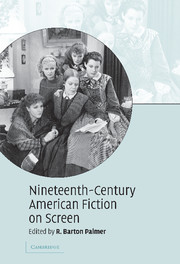Book contents
- Frontmatter
- Contents
- List of illustrations
- Notes on contributors
- Acknowledgments
- Introduction
- 1 A very American fable: the making of a Mohicans adaptation
- 2 Romancing the letter: screening a Hawthorne classic
- 3 The movies in the Rue Morgue: adapting Edgar Allan Poe for the screen
- 4 Readapting Uncle Tom's Cabin
- 5 Screening authorship: Little Women on screen 1933–1994
- 6 Melville's Moby-Dick and Hollywood
- 7 Screening male sentimental power in Ben-Hur
- 8 John Huston's The Red Badge of Courage
- 9 Translating Daisy Miller
- 10 Jane Campion's The Portrait of a Lady
- 11 The Europeans – and the Americans
- 12 Sister Carrie becomes Carrie
- 13 Hollywood and The Sea-Wolf
- 14 An untypical typicality: screening Owen Wister's The Virginian
- Filmography
- Index
Introduction
Published online by Cambridge University Press: 22 December 2009
- Frontmatter
- Contents
- List of illustrations
- Notes on contributors
- Acknowledgments
- Introduction
- 1 A very American fable: the making of a Mohicans adaptation
- 2 Romancing the letter: screening a Hawthorne classic
- 3 The movies in the Rue Morgue: adapting Edgar Allan Poe for the screen
- 4 Readapting Uncle Tom's Cabin
- 5 Screening authorship: Little Women on screen 1933–1994
- 6 Melville's Moby-Dick and Hollywood
- 7 Screening male sentimental power in Ben-Hur
- 8 John Huston's The Red Badge of Courage
- 9 Translating Daisy Miller
- 10 Jane Campion's The Portrait of a Lady
- 11 The Europeans – and the Americans
- 12 Sister Carrie becomes Carrie
- 13 Hollywood and The Sea-Wolf
- 14 An untypical typicality: screening Owen Wister's The Virginian
- Filmography
- Index
Summary
Since the early days of the commercial cinema, many, perhaps most, important works of literary fiction have found a subsequent life on the screen, extending their reach and influence. Filmmakers, in turn, have enjoyed the economic and critical benefits of recycling what the industry knows as “presold properties.” No doubt, this complex intersection has deeply marked both arts. Keith Cohen, for example, has persuasively argued that cinematic narrative exerted a decisive influence on the shift in novelistic aesthetics from “telling” to “showing,” providing new depth of meaning to the old maxim ut pictura poiesis. Film theorists, in turn, most notably Sergei Eisenstein, have emphasized the formative influence on cinematic storytelling of the classic realist novel, whose techniques and themes, adapted by D. W. Griffith and others, made possible a filmic art of extended narrative. Modern fictional form has been shaped by filmic elements such as montage, shifting point of view, and close attention to visual texture. An enabling condition of this constant and mutually fruitful exchange has been the unconventional conventionality of both art forms, their generic receptivity to outside influence. As Robert Stam puts it, “both the novel and the fiction film are summas by their very nature. Their essence is to have no essence, to be open to all cultural forms.”
Screen adaptations provide ideal critical sites not only for examining in detail how literary fiction is accommodated to cinematic form, but also for tracing the history of the symbiotic relationship of the two arts and the multifarious and ever-shifting connections between the commercial institutions responsible for their production.
- Type
- Chapter
- Information
- Nineteenth-Century American Fiction on Screen , pp. 1 - 8Publisher: Cambridge University PressPrint publication year: 2007



